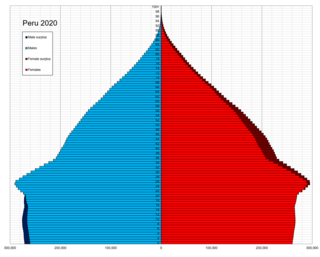
This is a demography of the population of Peru including population density, ethnicity, religious affiliations and other aspects of the population.

South America is a continent entirely in the Western Hemisphere and mostly in the Southern Hemisphere, with a considerably smaller portion in the Northern Hemisphere. It can also be described as the southern subregion of the Americas.

Lima, founded in 1535 as the Ciudad de los Reyes, is the capital and largest city of Peru. It is located in the valleys of the Chillón, Rímac and Lurín Rivers, in the desert zone of the central coastal part of the country, overlooking the Pacific Ocean. The city is considered the political, cultural, financial and commercial center of Peru. Due to its geostrategic importance, the Globalization and World Cities Research Network has categorized it as a "beta" tier city. Jurisdictionally, the metropolis extends mainly within the province of Lima and in a smaller portion, to the west, within the Constitutional Province of Callao, where the seaport and the Jorge Chávez Airport are located. Both provinces have regional autonomy since 2002.

Jorge Chávez International Airport is the main international airport serving Lima, the capital of Peru. It is located in Callao, 11 kilometers (6.8 mi) northwest of Lima Center, the nation's capital city and 17 kilometers (11 mi) from the district of Miraflores. In 2023, the airport served 22,876,785 passengers. Historically, the airport was the hub for Compañía de Aviación Faucett and Aeroperú. Now it serves as a hub for many aviation companies. The airport was named after Peruvian aviator Jorge Chávez (1887–1910). It is among the busiest airports in South America.

Peru, officially the Republic of Peru, is a country in western South America. It is bordered in the north by Ecuador and Colombia, in the east by Brazil, in the southeast by Bolivia, in the south by Chile, and in the south and west by the Pacific Ocean. Peru is a megadiverse country, with habitats ranging from the arid plains of the Pacific coastal region in the west, to the peaks of the Andes mountains extending from the north to the southeast of the country, to the tropical Amazon basin rainforest in the east with the Amazon River. Peru has a population of over 32 million, and its capital and largest city is Lima. At 1,285,216 km2 (496,225 sq mi), Peru is the 19th largest country in the world, and the third largest in South America.

Callao is a Peruvian seaside city and region on the Pacific Ocean in the Lima metropolitan area. Callao is Peru's chief seaport and home to its main airport, Jorge Chávez International Airport. Callao municipality consists of the whole Callao region, which is also coterminous with the province of Callao. Founded in 1537 by the Spaniards, the city has a long naval history as one of the main ports in Latin America and the Pacific, as it was one of vital Spanish towns during the colonial era. Central Callao is about 15 km (9.3 mi) west of the Historic Centre of Lima.

The 2004 Copa América was the 41st edition of the Copa América, the South-American championship for international association football teams. The competition was organized by CONMEBOL, South America's football governing body, and was held in Peru, who hosted the tournament for the sixth time, from 6 to 25 July.

Club Universitario de Deportes is a Peruvian sports club based in Lima, which has football as its main activity. It also has women's football, volleyball and basketball sections. The football team, popularly known as Universitario, has competed in the top tier of Peruvian football, the Liga 1, since 1928. They are the most successful team in Peruvian football with 28 titles and have never been relegated. The club was founded in August 1924 under the name Federación Universitaria by students of the National University of San Marcos but was forced to rename in 1931.

Miraflores is a district of the Lima Province in Peru. It is a residential and upscale shopping district south of downtown Lima. It is also one of the wealthiest districts that make up the city of Lima. It has several hotels, restaurants, bars, nightclubs, and department stores. Miraflores is one of the main tourist destinations in Lima.
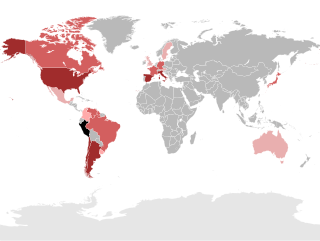
Peruvians are the citizens of Peru. What is now Peru has been inhabited for several millennia by cultures such as the Caral before the Spanish conquest in the 16th century. Peruvian population decreased from an estimated 5–9 million in the 1520s to around 600,000 in 1620 mainly because of infectious diseases carried by the Spanish. Spaniards and Africans arrived in large numbers in 1532 under colonial rule, mixing widely with each other and with Native Peruvians. During the Republic, there has been a gradual immigration of European people. Chinese and Japanese arrived in large numbers at the end of the 19th century.

According to the Organic Law of Regional Governments, the regions are, with the departments, the first-level administrative subdivisions of Peru. Since its 1821 independence, Peru had been divided into departments but faced the problem of increasing centralization of political and economic power in its capital, Lima.
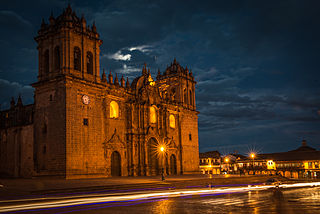
Christianity is the most widely professed religion in Peru, with Catholicism being its largest denomination.

The history of Lima, the capital of Peru, began with its foundation by Francisco Pizarro on January 18, 1535. The city was established on the valley of the Rímac River in an area populated by the Ichma polity. It became the capital of the Viceroyalty of Peru and site of a Real Audiencia in 1543. In the 17th century, the city prospered as the center of an extensive trade network despite damage from earthquakes and the threat of pirates. However, prosperity came to an end in the 18th century due to an economic downturn and the Bourbon Reforms.
San Miguel de Acos District is one of twelve districts of the province Huaral in Peru.
The following is a timeline of the history of the city of Lima, Peru.
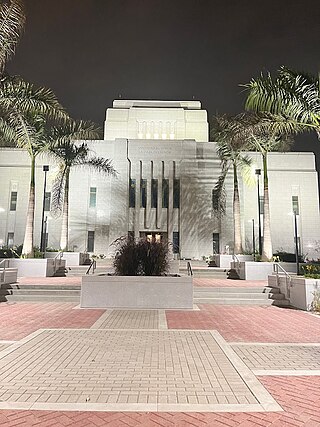
The Lima Peru Los Olivos Temple is a temple of the Church of Jesus Christ of Latter-day Saints in the San Martin de Porres district, Lima, Peru. The temple was dedicated by D. Todd Christofferson of the Quorum of the Twelve Apostles on January 14, 2024.
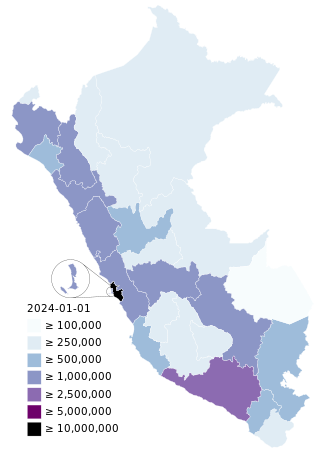
The COVID-19 pandemic in Peru has resulted in 4,528,708 confirmed cases of COVID-19 and 220,994 deaths. The virus spread to Peru on 6 March 2020, when a 25-year-old man who had travelled to Spain, France, and the Czech Republic tested positive. On 15 March 2020, President Martín Vizcarra announced a country-wide lockdown, closing borders, restricting domestic flights, and forbidding nonessential business operations, excluding health facilities, grocery stores, pharmacies, and banks. As of May 2023, Peru has the highest COVID-19 death rate in the world, with over 6,400 deaths per one million citizens.

Squatting in Peru is the occupation of unused or derelict buildings or land without the permission of the owner. From the 1940s onwards, Peru saw the illegal occupations of empty land, which created shanty towns known as barriadas and later pueblos jóvenes. Initially repressed, the Peruvian government eventually decided upon their toleration, and by 1998, it was estimated that 2.5 million inhabitants of Lima lived in such types of settlements. Similar slum tenements existed in the centre, known as solares or tugurios.





















